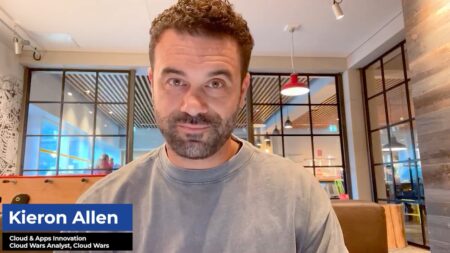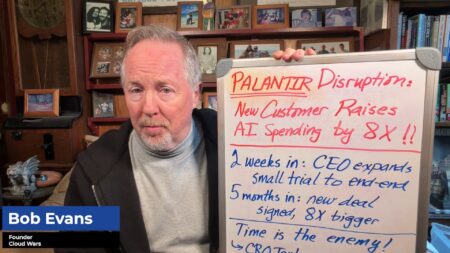
Of the many compelling and visionary perspectives shared by ServiceNow CEO Bill McDermott in our recent exclusive interview, the one that stood out to me most was his assertion that the #1 issue in the minds of CEOs today is technology.
You can see the full video interview here.
McDermott has long been not only one of the industry’s most-successful CEOs but also one of its most colorful in describing the impact technology can have on business, on society, and in our personal lives. Bringing a level of passion and optimism to his work that most CEOs choose to keep buried away, McDermott is able to articulate a unique vision for the impact that modern tech can have on businesses and the people working within those organizations.
And ServiceNow’s soaring success since McDermott’s arrival 3 years ago has provided the perfect backdrop for that type of vision. The company has publicly committed to nearly tripling its revenue to $15 billion over the next few years, and in the 5 years that I’ve been publishing the Cloud Wars Top 10, ServiceNow’s market cap has grown more rapidly (720%) over those 5 years than that of any other company on the list.
So when we spoke recently over Zoom as part of my CEO Outlook 2022 series, McDermott centered most of his comments on the changing needs and requirements of customers and on the resulting evolution ServiceNow has had to make to remain in lockstep with those rapidly evolving customers.
So from that conversation, here are several of my favorite excerpts from McDermott on customers, the future of digital business, exponential thinking, and more. The entire 30-minute interview is available on video here.
1. CEO Priorities
“If you look at the top three issues on the mind of CEOs today, #1 is technology,” McDermott said. “And they have to use technology as a force for growth. They know they can only do that by providing unbelievable experiences for their employees, and their employees right now are front and center of their everyday thinking because we’re in a global war for talent. And to win the global war for talent, you have to provide an extraordinary culture for your employees to operate in, particularly when they’re working from anywhere. And third is obviously the customer relationship. And how you have to think differently about serving your customers.”
“We learned from the pandemic that the customer is not necessarily coming to you, but you’re going to have to go direct to your customer. And you’re going to be highly predictive, and thoughtful in the way you maintain and create loyalty in that relationship. And by doing that well and empowering your people with the digital transformation tools, they need to serve the customer, you’re going to be able to achieve the upsell and cross-sell goals that you have.”
“By 2025, 40% of the revenue of the Global 2000 will come from digital revenue streams. And today, most of that is not even in business models that customers have activated. So the incline for digital transformation has never been greater.”
2. From Digital Transformation to Digital Business
“Today, the technology strategy is the business strategy. So discussing it as a sidecar, as if it was something off to the side doesn’t even make sense. The fact of the matter is, if you look at the businesses that were operating from 1989 to 2021 and that were the most highly valued corporations in the world, not a single one of them that were on that list in 1989 are still on that list in 2021. So you have to see things differently before you can do things differently. And what we’re focused on is making the world work better for everyone.”
“And it really does begin with a connected world that aligns the employee to the customer experience and essentially drives the business experience across multiple industries and multiple personas within the establishments we serve in the global economy. If you think about today’s discussions on rising interest rates and high inflation, the greatest deflationary force is information technology. And that is why digital transformation is so important, because it enables every worker you have to drive productivity and revenue per employee. But at the same time, because they now have the tools they need to do the job, it enables them to create the loyalty effect. And the net present value of a loyal customer is about the best idea any business can come up with.”
3. Industry-Specific Solutions
“If you think about what we have done in manufacturing, telco, government, financials, healthcare—all these industries require true domain expertise in the way you write the code, in the way you provision, the service, and the thought leadership and intellectual capacity of your team. And then ultimately the ecosystem is also participating in pursuit of the customer’s goals. We have enabled our entire “customer company” to do that, because being obsessed with our customers is our #1 goal around here and that has really made a difference.
“For example, we have a huge federal presence. And if you think about the Internal Revenue Service as an example, they’re on a multi-year digital transformation effort with us and they serve us very well with their requirements and then we listen to those requirements and we developed solutions around them that enabled us to take 12 complex systems and integrate them into one single platform, which is the Now Platform. And that Now Platform is supporting all of the agency’s mission-critical operations.”
“And you look at a different industry and a company like Unilever, where they’ve integrated 15 of their business operations into one operation on the ServiceNow platform, and they’re getting unique productivity advantages. One example is the time spent on employee support: they look at the time that the company is serving the employee to basically take care of problems versus serving the employee to drive productivity and outcome. And that, according to Unilever, has been one of the biggest breakthroughs that they’ve ever encountered.”
4. The Modern CIO as Highly Collaborative Leader across the C-Suite
“We’re seeing more CIOs essentially now teaming up with the CHRO, saying, ‘I know you have a problem with this employee experience—we’re battling this talent war together and I’m here to serve the business.’ And what you find is the systems of record that existed in the 20th century—which you know, Bob, better than anyone, Bob—they’re excellent. But they do a very specific thing. What we are doing is what I will call cross-enterprise collaboration or workflow automation, and that’s a different thing. And it actually makes all of those systems underneath the Now Platform more successful. Because now that CIO can say to the CHRO, ‘I feel your pain. We have to recruit, hire, train, onboard at record speed and manage all these cases”, McDermott said.
“This idea of the CIO orchestrating the C-level relationships has become a sensation. The CEO of a big bank recently told me, ‘Bill, I have to modernize 5,000 applications.’ I said, ‘Wow, when are you going to get that done?’ He says, ‘Oh don’t worry, I won’t be around by the time that’s done.’ And I said, ‘Well, maybe we should identify the top 25, and take a low code approach so you can get that done on your tenure and solve immediate problems, but also get revenue growth from your high-net worth clients where your problem seems to be most severe and drive usage up—that’s probably a good idea.’ He says, ‘You guys do that?’ And I said, ‘Yeah, we do that too.”
5. The Acceleration Economy and the Power of Co-Creation
“I mean, look at this idea of the acceleration economy, right? Everything is at such an accelerated clip and it’s all based upon providing these amazing experiences with service. Now, all of this can be customized: you’re not trapped in one way of doing something, you’re not stuck in an upgrade path where once you have that release, the next upgrade is going to create another moment of chaos where you’re going to have to go through yet another upgrade. All of the innovation that we do constantly gets built out into the Now Platform…. But also because you have the Creator capability on the platform, you can write your own workflows and your own applications onto the Now Platform. And when we upgrade or give you a major release, all of the work that you did, invisibly gets upgraded into the next release. So you’re never down. You’re never stuck…. So we’re never passing on any tech debt to our customers. And they trust us and they know that one platform and that one way of navigating digital transformation and that one control tower is generating enormous economic value.”
“The other thing, Bob, is we want to make everyone else’s technology better. There’s lots of great companies out there and they’re doing a really fine job. So we’re their friend and what they’ve done simply gets amplified with ServiceNow, and I think that’s another cultural imperative.”
“I keep saying nobody has to lose for us to win because we all work for the customer. They’re the only boss.”
You can watch the full interview with McDermott to catch more of his insights here.








